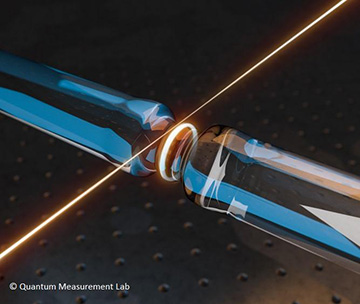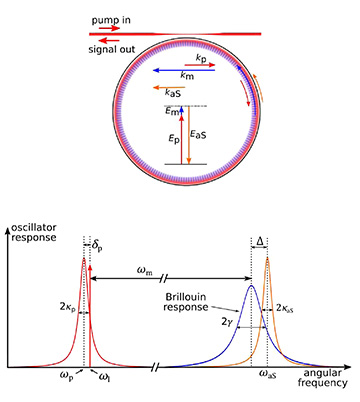
Light (shown in orange) is injected into an optical microresonator via a tapered optical fiber. The light circulates many thousands of times inside the structure and couples strongly to high-frequency acoustic waves. [Image: Quantum Measurement Lab, Imperial College London]
Researchers at the University of Oxford, Imperial College London and the National Physics Laboratory, U.K., have demonstrated strong coupling between light and high-frequency acoustic vibrations in a silica microresonator (Optica, doi: 10.1364/OPTICA.6.000007). The team believes the work—which achieves a long-standing goal in optomechanics—could open interesting prospects in exploiting light–sound coupling for technology development in both the classical and quantum domains.
Stokes vs. anti-Stokes
The work involves the well-known nonlinear phenomenon of Brillouin scattering, first described in the 1920s by the French scientist Leon Brillouin. Essentially, Brillouin scattering involves the interaction of photons of light with phonons of thermal or acoustic energy in the material in which the light propagates; that interaction, in turn, produces scattered light at a characteristic frequency shift. In the so-called Stokes process of Brillouin scattering, the frequency of the scattered light is downshifted relative to the pump light; the much weaker anti-Stokes process results in scattered light at a higher frequency than the pump light.
Stokes scattering has been much more widely studied than anti-Stokes scattering. That’s partly because the Stokes process can give rise to stimulated Brillouin scattering (SBS), a self-reinforcing effect in which the scattered light gives rise to new acoustic vibrations which in turn lead to increased scattering. Historically, SBS has proved troublesome in long-haul fiber communications—though, more recently, it has offered the prospect of on-chip applications (see “Harnessing On-Chip SBS,” OPN, February 2015).
But researchers have increasingly realized that the weaker anti-Stokes process offers some hidden gold of its own. In particular, the ability to achieve strong coupling of photons and high-frequency phonons in the anti-Stokes process could find applications in optical and quantum memory, in sensing devices, and even for coherent conversion between the optical and microwave domains in communications.
Getting to that strong-coupling regime has been a challenge, however. One reason is that both the acoustic and optical energy tends to dissipate in materials through a variety of friction-like processes, preventing strong acoustic-optical coupling. And boosting pump powers to overcome these effects and achieve strong coupling in the anti-Stokes regime also increases the much stronger Stokes process and SBS effects, potentially swamping the signal.
Silica microresonator
To get around these issues, the U.K. team began with a shrewd choice of material. Specifically, the researchers opted to perform their experiments in fused silica, a material with far lower optical propagation losses than alternative platforms such as silicon.
Using that material, they fashioned a 700-μm-diameter micro-rod resonator capable of supporting two optical whispering-gallery modes—one at the lower pump frequency of 1550 nm, and one at the higher anti-Stokes frequency. The two modes are thus separated by approximately the mechanical frequency of the acoustic phonons in the material. The team used tapered microfiber to tie the resonator to the input pump light source and output photodetectors.

In the experimental microresonator system, pump light interacts with a counterpropagating, 11-GHz mechanical wave to create scattered anti-Stokes signal light at a higher frequency. The microresonator is designed to support two optical whispering-gallery modes separated by the anti-Stokes mechanical frequency—a design that favors anti-Stokes scattering and suppresses Stokes scattering. [Image: G. Enzian et al., Optica, doi: 10.1364/OPTICA.6.000007]
As pump light enters the microresonator, it gives rise to a counterpropagating mechanical wave at an 11-GHz frequency, which interacts with the pump field to create scattered, back-propagating light at the higher anti-Stokes frequency. The anti-Stokes light is then skimmed off by the tapered fiber and sent to a photodetector for analysis. Because the ring microresonator supports only the pump and anti-Stokes modes, and is not resonant at the lower Stokes frequency, Stokes scattering (and, hence, the problem of stimulated Brillouin scattering) is almost completely suppressed. That allowed the team to ramp up pump powers and thereby improve the prospects for demonstrating anti-Stokes acoustic-optical coupling.
Applications in classical and quantum information
The team used a heterodyne-detection setup to assess the resonator system’s optomechanical spectra at various pump powers. For sufficient power levels, the researchers found that the resonator normal mode split into two peaks. That splitting, according to numerical modeling, is a key signature of strong optomechanical coupling between the pump photons and the 11-GHz acoustic phonons—essentially, the swapping of mechanical and optical energy at a specific rate.
The coupling performance could be improved further, the authors note, by further tweaking the cavity design and materials and by performing the experiments at cryogenic temperatures, to reduce thermal, mechanical damping and decoherence effects. Those improvements could, in the view of the researchers, “provide a rich avenue to develop a suite of new technologies, including classical and quantum information-processing applications and sensors, and even provide a path for coherent X-band microwave-to-optical conversion.”
